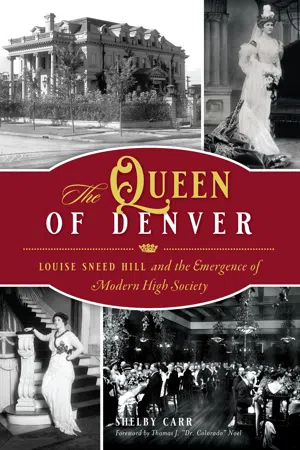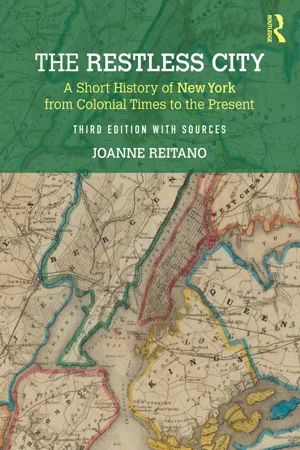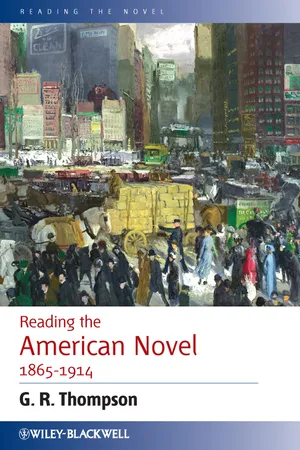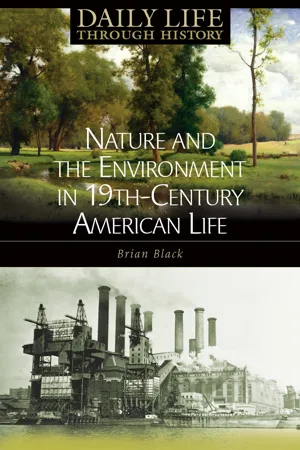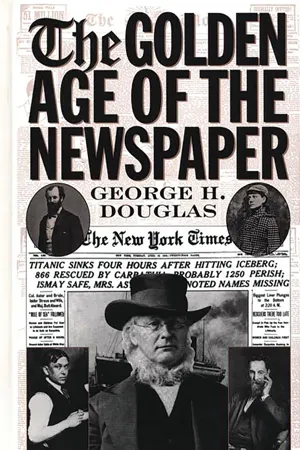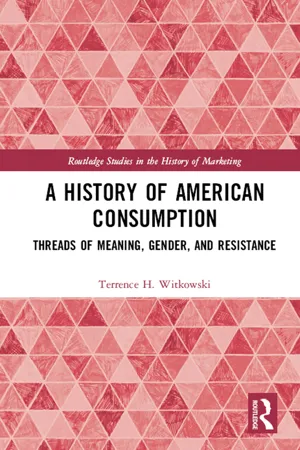History
Gilded Age New York
Gilded Age New York refers to the period in the late 19th century characterized by rapid economic growth, industrialization, and ostentatious displays of wealth. It was a time of extreme social inequality, with the wealthy elite living lavishly while many others struggled in poverty. The era saw the rise of influential figures like J.P. Morgan and the construction of iconic landmarks such as the Brooklyn Bridge.
Written by Perlego with AI-assistance
Related key terms
1 of 5
8 Key excerpts on "Gilded Age New York"
- eBook - ePub
The Queen of Denver
Louise Sneed Hill and the Emergence of Modern High Society
- Shelby Carr(Author)
- 2020(Publication Date)
- The History Press(Publisher)
3 IT HAPPENED ON FIFTH AVENUEThe Gilded Age, an era of decadence in the United States, is still known today as perhaps the most lavish period in the country’s history. Money was key and appeared to rule all. Modest, unassuming dress and decorative style was out of fashion, and the more apparent you could display your great wealth through opulent parties and expensive objects the better. There was nowhere in which opulence, high society and class division were more apparent than they were in New York City.The formation of the bourgeoisie in New York began centuries before it came to full fruition during the Gilded Age. Families such as the Astors, Beekmans, Schermerhorns, Van Burens, Van Rensselaers, and Whitneys settled in New York during and prior to the eighteenth century and had made somewhat of a name for themselves. They were predominantly Dutch settlers and were known as the Knickerbockers, so named after the knee-length pants that were worn by the Dutch. According to historians Gail MacColl and Carol Wallace, Knickerbocker families were typically landowners, heirs, lawyers and bankers who lived in modesty in side-by-side brownstones, hosted sophisticated events, and dressed with a moderate refinement and practicality.134 Some knickerbocker men involved themselves in big business and continued to grow their family fortunes during the late nineteenth century. The Knickerbocker society developed into the aristocracy of “old” New York during the Gilded Age. They ran the press in New York City and heavily controlled what newspaper reporters said about them and others in their social spectrum. This helped them effectively create their class exclusivity. Therefore, they were able to create a public persona in which they were the epitome of high class and unattainable but forever desired success.New York City was a thriving metropolis, and by 1800, it was the largest city in America. As the country’s cultural and social capital, the city continued to flourish during the Gilded Age. New York City, which had once held a small population of thirty thousand at the turn of the nineteenth century, roughly doubled in size every decade henceforth. This rapid increase in population resulted in approximately 4 million people residing within the city limits by the beginning of the twentieth century.135 - eBook - PDF
Guide to U.S. Foreign Policy
A Diplomatic History
- Robert J. McMahon, Thomas W. Zeiler, Robert J. McMahon, Thomas W. Zeiler(Authors)
- 2012(Publication Date)
- CQ Press(Publisher)
51 ★ b y N i c o l e M . P h e l p s c h a p t e r 4 The Gilded Age D uring the Gilded Age, the period from the end of the Civil War (1861–1865) through the mid-1890s, Americans were faced with dramatic changes that prompted many to recon-sider their place in the world and what it meant to be American. Mid-nineteenth-century technological innova-tions prompted dramatic economic growth and industrial-ization in the United States, and it also produced a strong interest in international trade. Industrialization, plus the end of slavery, prompted the development of new labor condi-tions. Domestically, those conditions produced a pro-nounced class system. Abroad, it produced a foreign policy that was remarkably close to imperialism, though instead of direct political control, U.S. leaders stressed the development of close economic ties, a process facilitated by a reinvigorated Monroe Doctrine, which claimed the Western Hemisphere as a zone of exclusive U.S. influence. In 1898, the United States became a formal empire, following the British exam-ple by strengthening its navy to guarantee its economic and political global power. Americans also embraced key aspects of the Great Power diplomatic system, expanding their dip-lomatic and consular presence overseas and participating in major international conferences and dispute resolutions. The key idea for Americans’ understanding of their position in the world during the Early National period was the antithesis between the New World and the Old, but in the Gilded Age, that idea was giving way to the concept of “civilization.” Rather than seeing themselves as the oppo-site of Europeans, many Americans came to see themselves as part of the same advanced culture and society as Europe, and the new antithesis was “barbarism,” which could be found among the lower classes and dark-skinned people around the globe. - eBook - ePub
The Restless City
A Short History of New York from Colonial Times to the Present
- Joanne Reitano(Author)
- 2018(Publication Date)
- Routledge(Publisher)
7To emphasize the point, Twain wrote a short story about an industrious but impoverished boy who followed Alger’s prescriptions for success only to discover that the rich were mean and miserly instead of kind and generous. “Such is life as I find it,” Twain wryly remarked. His parody of Alger challenged prevailing assumptions that the rich were deserving and superior, whereas the poor were undeserving and inferior. Like Crane and George, Twain questioned the relationship between myth and reality.8Much of reality fed the myth. Befitting its imperial prowess, New York’s accomplishments in this period were grandiose. The economic city was energized by robber barons, so called for the unprecedented and unsavory methods they used to dominate their businesses. John D. Rockefeller’s Standard Oil Trust, Cornelius Vanderbilt’s New York Central Railroad, Andrew Carnegie’s steel trust, Jay Gould’s brokerage firm, and J. P. Morgan’s banking house made Wall Street the symbolic and actual home for new companies of phenomenal wealth controlled by a few men. Aggressive businessmen, notes historian Thomas Kessner, were always “New York’s heroes.” In the Gilded Age, they made Gotham the crown jewel of America’s economic empire—the nexus for national and international business.9Rockefeller (1839–1937) was the archetypical robber baron of the era. A pious farm boy from western New York, Rockefeller’s frugality, shrewdness, and hard work led to big city success and stupendous wealth. He personified the rags to riches myth, minus Ragged Dick’s cheerful charm. Although a generous philanthropist in his later years, Rockefeller’s austere manner, ruthless business techniques, and “a mouth that was a slit, like a shark’s” confirmed widespread opinion that he was “the greatest villain” of the Gilded Age. To many, however, he remains a brilliant innovator who modernized the American economy.10 - eBook - ePub
- G. R. Thompson(Author)
- 2011(Publication Date)
- Wiley-Blackwell(Publisher)
Chapter 16 The “Gilded Age” Genteel Critics and Militant MuckrakersThe Gilded Age (1873) by Mark Twain and Charles Dudley Warner gave the Age of Big Business one of its most memorable labels. In American cultural history, the term “Gilded Age” invokes the period from the end of the Civil War through the 1890s, and slightly beyond. Associated with the rapid rise of Big Business are the Labor Movement, the Factory System, and the attempt of Corporate Capital (personified as the Robber Barons) to control it all – by violence if necessary. Within this time frame, political historians have identified other periods, most notably Reconstruction and the Progressive Era, terms embodying the contradictory tendencies of the times. But for most literary scholars and cultural critics, the “Gilded Age” is the label that has stuck.1The term emphasizes the problems and evils of laissez-faire capitalism. Gilded means covered with a thin layer of (usually) fake gold. In their comic Dickensian way, Twain and Warner strip away the pretty surface and expose the ugliness beneath the top layer of society, politics, and business. The word gilded also suggests American Victorian respectability and artifice, from the gilt-edges and decorations of fake books in simulated libraries, to elaborate gilded picture frames in over-decorated parlors, to insincere piety regarding personal behavior and business ethics.Novels of social criticism in the era generally took one of two forms: “genteel criticism” and “muckraking.” Among the Genteel Critics and historical romancers who sometimes cast a jaundiced eye on American manners, morals, and institutions are Henry Adams, Booth Tarkington, Winston Churchill, Robert Herrick, and W. D. Howells. The Muckrakers wrote both fiction and nonfiction in which they more militantly exposed the ugly underside of American capitalism and putative democracy. Important muckraking works include novels by Rebecca Harding Davis, John William De Forest, and David Graham Phillips; and journalistic exposés by Ida Tarbell, Lincoln Steffens, Jacob Riis, Thorstein Veblen, and Helen Hunt Jackson. The most famous of the American muckraking novels is Upton Sinclair's The Jungle - Brian C. Black(Author)
- 2006(Publication Date)
- Greenwood(Publisher)
Overall, the expanding economy of the late nineteenth century was ripe for development by those with foresight and an aggressive approach to business. However, the new era of industry clearly created a distinct working class. The ethics with which the few successful tycoons managed their workforces are considered extremely dubious by today’s standards. During the Gilded Age, many capitalists dismissed considerations of workplace safety and human welfare in order to create the greatest possible profits. For instance, child labor became a norm in factories, mines, and other extremely dangerous environments, largely because children required the least pay. All industrial growth surged after the Civil War. This growth and a general faith in economic development allowed a few corporations to gain control of entire commodities and their production. Called trusts, these conglomerates were near monopolies during an era when government and society had not yet defined such an entity as evil. With such power reform faced a mighty plifying production tasks and la concentrated in a single entity, any efforts for challenge. Against a culture in which these ethics were the norm, a younger gener- ation came of age in the 1890s and began to demand reform. Initially, one of the most common outlets for voicing discontent was journalism. The impassioned pleas of concerned journalists, then, found receptive ears among the elite women of the era. Activists such as Jacob Riis, who wrote How the Other Half Lives in 1890 to describe life in New York City slums, and Jane Addams, who started Hull House to aid immigrant acclimation to American culture, led a movement for progressive reform. Ironically, the wealth of some robber barons would contribute to the evolution of a public consciousness on issues such as ghettos, environmental degradation, and unfair labor practices.- Gregory Feldmeth, Christine Custred, Christine Custred(Authors)
- 2015(Publication Date)
- Research & Education Association(Publisher)
Chapter 8 Industrialism and the Gilded Age (1865–1898)The period between the end of the Civil War and the beginning of the 20th century is known as the Gilded Age. Mark Twain first used the term “Gilded Age” to describe the years after the Civil War. He saw rampant greed, materialism, and corruption dominating American political and social life and viewed the outward appearance of prosperity and gaiety as being nothing more than a thin coating of gold on a fundamentally flawed society.Politics of the Period, 1877–1882The presidencies of Abraham Lincoln (1861–1865) and Theodore Roosevelt (1901–1909) mark the boundaries of half a century of relatively weak executive leadership, and legislative domination by Congress and the Republican Party.The Compromise of 1877With Southern Democratic acceptance of Rutherford B. Hayes’s Republican presidency, the last remaining Union troops were withdrawn from the Old Confederacy (South Carolina, Florida, Louisiana), and the country was at last reunified as a modern nation-state led by corporate and industrial interests. The Hayes election arrangement also marked the government’s abandonment of its earlier vague commitment to African American equality.Republican Factions“Stalwarts” led by New York Senator Roscoe Conkling favored the old spoils system of political patronage. “Half-Breeds” headed by Maine Senator James G. Blaine pushed for civil service reform and merit appointments to government posts.Election of 1880In the 1880 presidential election, James A. Garfield of Ohio, a Half-Breed, and his vice presidential running mate, Chester A. Arthur of New York, a Stalwart, defeated the Democratic candidate, General Winfield S. Hancock of Pennsylvania and former Indiana congressman William English. Tragically, the Garfield administration was brief, as the president was assassinated in 1881 by a disturbed office-seeker, Charles Guiteau. Though lacking much executive experience, the stalwart Arthur had the courage to endorse reform of the political spoils system by supporting passage of the Pendleton Act (1883), which established open competitive examinations for civil service positions.- eBook - PDF
- George H. Douglas(Author)
- 1999(Publication Date)
- Greenwood(Publisher)
7 Newspapers in the Gilded Age In the 1870s and 1880s American newspapers, at least in the country's ma- jor metropolitan areas, were rapidly becoming big businesses. In part this was because business itself was becoming big. The nation was drifting away from the old agrarian ways to the new and often bewildering values of an urban society. It was an age of business triumphant, of capitalism ram- pant—an age of large corporations, of trunk line railroads, of trusts, of in- vestment banking, of robber barons, and rags-to-riches millionaires. Since there was a dramatic shift in the character of society, and because cities were filling up with new waves of European immigrants, there would be a need for more newspapers everywhere (many in foreign languages), and a need for existing papers to increase their number of pages and their circulations. In a city like New York, now the principal port of embarkation for those arriving from abroad, an unhealthy bursting at the seams had already been apparent for a long time. Even before the Civil War the city was being tested to its limits. Between 1840 and 1860 the population of New York increased from 312,000 to 813,000—and this did not include nearby independent communities like Brooklyn and Queens, which were themselves large cities and did not become part of the Greater City of New York until 1898. If you added the populations of these places and nearby suburban areas in New Jersey, Long Island, and Connecticut, you had a metropolitan population of 1,600,000 by I860. 1 82 The Golden Age of the Newspaper Of course the same painful growth was going on in all of the nation's ma- jor cities. Chicago's growth before the great fire of 1871 was even more rapid than that of New York. Elsewhere, small and medium-sized cities were expanding dramatically, nearly always at the expense of smaller rural communities. - eBook - ePub
A History of American Consumption
Threads of Meaning, Gender, and Resistance
- Terrence Witkowski, Terrence H. Witkowski(Authors)
- 2017(Publication Date)
- Routledge(Publisher)
In April of 1886, a minor boycott of widow Esther Gray’s small, nonunion bakery in New York City garnered a great deal of negative attention in newspapers across the country and led to a counter- or anti-boycott where local consumers patronized her business in a show of support (Glickman 2009, 140). After Chicago’s Haymarket Affair of May 4, 1886 – a dreadful incident where someone threw a bomb that killed seven policemen in the process of dispersing a peaceful labor demonstration for an eight-hour workday – anti-union sentiment greatly intensified across the country. By 1890, the Knights of Labor had declined precipitously, but eventually other unions were formed. As subsequent chapters will show, the boycott as an act of consumer resistance would endure throughout the twentieth and into the twenty-first century.SummaryIn many ways the Gilded Age marked an intermediate period in American consumption history, a time bridge between the largely agrarian, pre-industrial past and the increasingly urbanized, materially abundant lifestyles of the future. Transformative new technologies including electric power and lighting, internal combustion engines, the telephone and phonograph, and very rudimentary motion pictures were being invented and tested, but were not sufficiently refined to reach a broad market until after 1900. The consumer marketing infrastructure saw the development of department and five-and-ten cent stores, mail order selling and distribution, magazine publishing and color printing, and new types of consumer packaging. Yet, these innovations also would not fully permeate society until the twentieth century. Per capita incomes increased after the Civil War, but aggregate statistics masked rising inequality based on race, ethnicity, and occupational status.Traditional threads of refinement found new modes of expression in public art collections and through the privately furnished spaces of Victorian parlors and hallways. Inspired by the 1876 Centennial celebrations, goods continued to carry patriotic associations, while brand names and promotional ephemera, especially trade cards, became repositories for a wide assortment of meanings including some that played upon racist stereotypes. The gendering of household consumption activities and products became more pronounced with women increasingly assuming domestic primacy. Retailers clearly understood this trend and increasingly focused on their female clientele. Yet, by the end of the century, the separate sphere of men’s consumption was becoming problematic especially in regards to the drinking of alcohol. The ostentation and materialism of the very rich received a well-deserved share of criticism, while common people adopted the consumer boycott as a tactic in their collective struggles with unbridled and powerful capitalism. Overall, however, resistance to consumption norms was rather muted in the Gilded Age. That would change in the twentieth century.
Index pages curate the most relevant extracts from our library of academic textbooks. They’ve been created using an in-house natural language model (NLM), each adding context and meaning to key research topics.
